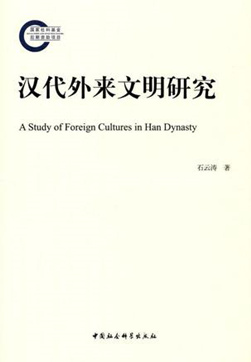
. > WHAT'S NEW > BOOKS
Rise of China-foreign exchanges in Han Dynasty
Author : LI HONGBIN Source : Chinese Social Sciences Today 2018-04-18

A Study of Foreign Cultures in Han Dynasty
Author: Shi Yuntao
Publisher: China Social Sciences Press
Shi Yuntao’s newly published A Study on Foreign Cultures in Han Dynasty comprehensively demonstrates how extraterritorial material and spiritual civilizations enriched the Han world. The book relies on handed-down literature and archaeological discoveries, including animals, plants, utensils, furs and textiles, spices, medicine, jewelry, art, and even Buddhism’s early texts and poems, to show a vivid picture of life in the Han Dynasty.
Scholars often assert that the emergence of specific artifacts and cultures, and their resulting impact on Chinese society, strengthened China-foreign communications. However, these kinds of exchanges may have resulted from deeper reasons: the growing central empire and its influence on neighboring countries. In terms of the structure of political power, the Han Dynasty was centered around the royal court and bureaucratic aristocracy, forming a power structure that governs the expansion of Han society from the inside to the outside. The sub-societies under central control also expanded from the core area of the Central Plains to the surrounding periphery. When this core circle continued to expand from the center to surrounding areas, the areas it encountered were populated by different ethnic groups.
An empire of agriculture that relies on stable settlements is often characterized by a self-centered circle structure and a mindset based on this. Subjectivity is one major feature. The expansion of the Han Empire to the prairies, the Northeast, the Western Regions, and even the hinterland of the South, which happened before and after Zhang Qian’s journey to the Western Regions, was an important factor that affected the discourse system of the Han Dynasty. This has also become the core spirit and basic characteristic of the research paradigm of Chinese and foreign exchanges in Chinese academic circles since modern times. While we use “centrism” discourse to describe it, we also notice its closeness and self-satisfaction. This kind of discourse cannot avoid the reflection of “isolation” while being linked with the “center.” In other words, it is not necessary for a self-reliant farming empire to depend on the outside world. Therefore, Chinese-foreign exchanges, or the involvement and influence of foreign civilizations, are all based on the mode of thinking of “self-focus,” leading to one-directional communication.
The corresponding observation perspective, that is, the paradigm of global history, breaks the set pattern of the dynasty’s self-centeredness, and regards the empire as only one part of the world. One of the important features of the book that was different from the past is that it transcends the observational landscape beyond a one-way pattern and has a multidimensional shift.
Han society developed after the founding of the dynasty due to a number of reasons. In addition to the appropriate measures adopted by the ruling cliques at various levels of politics, economics, military affairs, ideology and culture, there were also the exchanges with foreign cultures. These were all important factors in promoting Han society’s prosperity.
(Edited and translated by SUI JINGJING)
Ye Shengtao made Chinese fairy tales from a wilderness
Ye Shengtao (1894–1988) created the first collection of fairy tales in the history of Chinese children’s literature...
-
How northern ethnicities integrated into Chinese nation
2023-09-18
-
Mogao caves
2023-09-12
-
Mogao Grottoes as ‘a place of pilgrimage’
2023-09-12
-
Time-honored architectural traditions in China
2023-08-29
-
Disentangling the civilizational evolution of China
2023-08-28
-
AI ethics in science fiction
2023-08-23













 2011-2013 by www.cssn.cn. All Rights Reserved
2011-2013 by www.cssn.cn. All Rights Reserved